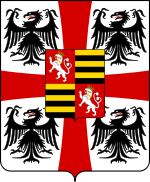House of Gonzaga
| Gonzaga | |
|---|---|
| Noble house | |

|
|
| Country |
|
| Estates |
Ducal Palace (Mantua) Ducal Palace (Nevers) |
| Titles | |
| Style(s) | "Saint" "Grace" "Excellency" |
| Founded | 1100 |
| Founder | Ludovico I Gonzaga |
| Final ruler | Ferdinando Carlo Gonzaga |
| Current head | Maurizio Ferrante Gonzaga (head of a cadet branch) |
| Deposition | 1708 |
| Ethnicity | Italian |
The House of Gonzaga (Italian: [ɡonˈdzaːɡa]) was a princely family that ruled Mantua, in Northern Italy, from 1328 to 1708; they also ruled Monferrato in Piedmont and Nevers in France, and also many other lesser fiefs throughout Europe. Their family includes a saint, twelve cardinals and fourteen bishops. Two Gonzaga descendants became Empresses of the Holy Roman Empire (Eleonora Gonzaga and Eleonora Gonzaga-Nevers), and one became Queen of Polish-Lithuanian Commonwealth (Marie Louise Gonzaga).
The first members of the family of historical importance are known to have collaborated with the Guelph faction alongside the monks of the Polirone Abbey. Starting from the 12th century they became a dominant family in Mantua, growing in wealth when their allies, the Bonacolsi, defeated the traditional familiar enemy, the Casalodi. In 1328, however, Ludovico I Gonzaga overthrew the Bonacolsi lordship over the city with the help of the Scaliger, and entered the Ghibelline party as capitano del popolo ("people's captain") of Mantua and imperial vicar of emperor Louis IV.
Ludovico was succeeded by Guido (1360–1369) and Ludovico II (1369–1382), while Feltrino, lord of Reggio until 1371, formed the cadet branch of the Gonzaga of Novellara, whose state existed until 1728. Francesco I (1382–1407) abandoned the traditional alliance with the Visconti of Milan, in order to align their rising power with the Republic of Venice.
...
Wikipedia
